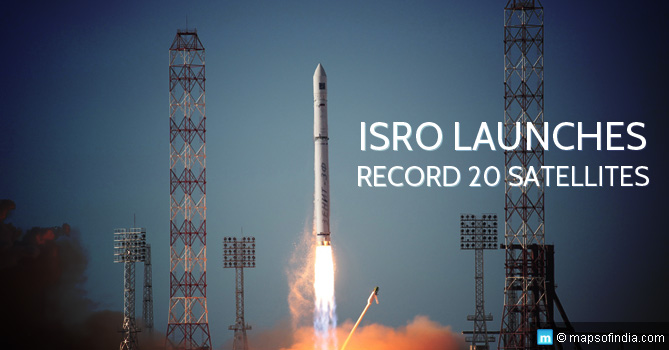On 22 June, 2016 ISRO (Indian Space Research Organisation) created a record by launching 20 satellites in a single mission. The launch happened at Satish Dhawan Space Centre in Sriharikota, Andhra Pradesh. The satellites are a part of Cartosat-2, a series of earth observation satellites made by the said body. The process was started by health checks of the spacecraft in question. The scientists also prepared the propellant filling operations for the second stage of PSLV-C34. This second stage was termed PS2. The whole launch was fixed for a 48 hour countdown that had started at around 9:26 am on 21 June. The 20 satellites were to be launched aboard PSLV-C34.
Details of Cartosat-2 Series and PSLV
As per ISRO, Cartosat-2 Series is a lot like the previous synonymous version as well as Cartosat-2A, Cartosat-19 and Cartosat-2B. All of these were co-passenger satellites as well. It weighed 560 kg at lift-off and was injected into a polar Sun Synchronous Orbit that spanned a distance of 505 km. ISRO also stated that the 20 satellites weighed approximately 1,288 kg in all. The process of launch started at around 8:55 AM on 22 June. Before the launch happened, a film was shown on how the various satellites being launched and PSLV-C34 were going to be integrated. The weight of Cartosat-2 is 725.5 kg. The rocket weighs around 320 tons and is 44.4 metres tall.
The Launch mission
The launch was authorized by mission director B. Jayakumar at around 9:22 AM. Around four minutes later, the launch vehicle blasted off from Sriharikota. At around 9:36 AM the launch vehicle reached the fourth stage. Cartosat was supposed to be the first one to be launched in the orbit followed by the other satellites. At 9:45 AM, Cartosat-2 series was launched successfully into the outer space. After this, the rocket successfully launched satellites called Swayam and Sathyabamasat. By 9:46 AM, the launch mission was completed successfully. Among the 20 satellites supposed to perform imaging and earth observation functions, 17 were foreign satellites. The international satellites were from countries such as the US, Germany, Canada and Indonesia. A couple was contributed by College of Engineering, Pune and Sathyabama University of Chennai.
Praise from all quarters
After the launch, there were plenty of congratulatory messages with Narendra Modi being one of the first to do so. The director of Satish Dhawan Space Centre (SDSC), P. Kunhikrishnan, termed the successful mission a symbol of the organization’s success as well as that of India in general. S. Somnath, director of Liquid Propulsion Systems Centre (LPSC), ISRO, pointed out the technical issues suffered during the launch like how the engine had to be restarted twice during the fourth stage. The director of ISRO Satellite Centre announced that two more satellites for earth observation will be launched prior to 31 March 2017. ISRO chairman Kiran Kumar also expressed his satisfaction at having completed the job successfully.
Following the successful launch, Prime Minister Narendra Modi noted that in the last few years, India has been able to develop the skills and capacity necessary to help other countries in their space research-related initiatives as well. He also applauded scientists for achieving such high levels of skill. He expressed his happiness is seeing students from Chennai and Pune participating constructively in the satellite launch.
Union Ministers Rajyavardhan Rathore and Rajnath Singh also congratulated the ISRO team for the way it was able to come up with such unprecedented engineering feat.
Why this launch is important
ISRO has a history of placing such satellites in the orbit – especially several satellites at once with a single launch. In terms of numbers, however, this is the best that the premier space research organization of India has done. Its previous record was that of 10 satellites which were launched in April 2008. Till now, India has been successful in launching 57 satellites made outside the country. As far as launching the maximum number of satellites in one launch is concerned, Russia tops the list. In 2014, its Dnepr rocket had launched 37 satellites in outer space.
Read More:
ISRO launch GSAT-6 communication satellite
ISRO: Touching space and beyond
India’s Seventh Navigation Satellite





